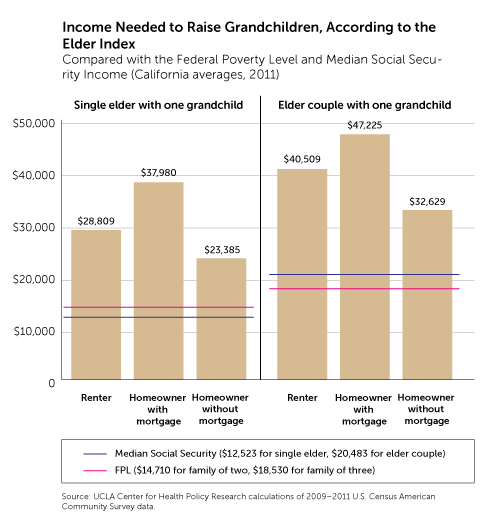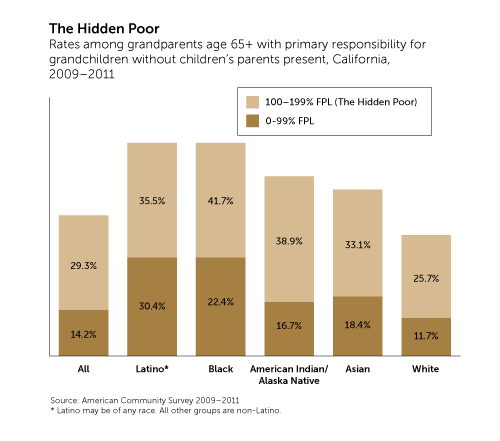Measuring Economic Security for Grandparents Raising Grandchildren 
By capturing the actual costs associated with meeting basic needs, a new tool can measure the economic security of grandparents raising grandchildren.
In 2011, 7 million U.S. grandparent heads of households had a grandchild living with them. Approximately 3 million had primary responsibility for meeting their grandchildren's basic needs. In New England alone, 237,000 grandparents had grandchildren living with them, and 77,000 were the primary caregivers.[1]
But grandparents over 65 often face financial challenges supporting an additional dependent on a retirement income without financial help from the child's parents. Financial hardships can have an impact on the emotional, mental, and physical well-being of both grandparent and grandchildren.[2] Nationally, more than one in four grandparent caregivers lives in overcrowded conditions, more than one in six pays over half their income in rent, and 60 percent who qualify for rent subsidies do not receive any.[3] As for the grandchildren, although 48 percent of those living with grandparents experience some food insecurity, only about 43 percent receive food stamps.[4]
Measuring Economic Security
The Federal Poverty Guidelines (Federal Poverty Levels, FPL) are the official measure of the minimum income needed to meet the basic needs of individuals and families. The amounts are often used to set eligibility and benefits for public programs. But numerous studies have documented that the FPL is an outdated and inaccurate reflection of the actual incomes families need. It is also a poor metric to identify the economic needs of custodial grandparents.[5]
The Supplemental Poverty Measure (SPM) was developed to address FPL shortcomings, but being based on individuals' current spending, it doesn't necessarily measure actual need.[6] It includes people who spend only $100 on food per month, but that amount may represent food insecurity. A better way to measure economic security is to capture the actual costs associated with basic needs, such as shelter, food, health care, and transportation.
Enter the Elder Economic Security Standard Index, an evidence-based measure of economic security that reflects the current actual cost of basic needs at the county level for retired adults age 65 and over who receive no public assistance. The index was developed by Wider Opportunities for Women and the University of Massachusetts, Boston, Gerontology Institute to address the failings of the FPL for older adults. The UCLA Center for Health Policy Research and the Insight Center for Community Economic Development adapted the index and calculated it for California. As of September 2011, California law requires Area Agencies on Aging to use the index for program and planning purposes.[7]
The California Elder Index starts with housing costs for three different housing types in each county: renters, homeowners with a mortgage, and homeowners without one. To each of those, the index adds a county-adjusted cost of food from the U.S. Department of Agriculture's low-cost diet, health-care costs from local insurance data and national out-of-pocket cost data, car transportation costs, and an additional percentage of total costs for miscellaneous expenses. Driving the high cost of living for older adults are housing and health care.[8]
The California Elder Index for Grandparents builds on the basic living expenses of older singles and couples to include additional expenses for grandchildren: housing, food, transportation, school supplies, clothing, and personal care.[9] The estimates are conservative and based on two assumptions: that child care is not needed if grandparents are retired and that their grandchildren's health insurance is covered through no-cost Medicaid. The calculations reveal that the average California grandparent who rents and is the primary caregiver of a grandchild needs twice the FPL to maintain a basic standard of living. Even older adults who own their own home with a paid-off mortgage-and who incur no additional housing costs for the grandchild-face expenses over 1.5 times the FPL. (See "Income Needed to Raise Grandchildren.)

If we use 200 percent FPL as an approximate measure of basic economic security for this group, about 43 percent of older grandparents responsible for grandchildren in California do not have enough income to make ends meet. Twentynine percent are among the hidden poor-people whose incomes are above the FPL but not enough to meet basic living expenses. Such individuals, often overlooked in policy, are found disproportionally among racial and ethnic minorities. (See "The Hidden Poor.")

Addressing the Financial Gap
Access to stable and sufficient financial resources can help grandparents provide a basic living for themselves and their grandchildren. The Elder Index's more accurate reflection of the cost of living can help policymakers better target this population's basic needs.
Some minor children are placed with grandparents through the foster care system. At a national level, in order to receive federal foster care aid, a grandchild must meet narrow and complex eligibility rules, and an increasing number don't qualify.[10] In California, not all grandparents are eligible for state foster care benefits or the Kinship Guardianship Assistance Payment Program (Kin-Gap).[11] Providing financial assistance to grandparents costs less than placing the children in foster care, which can cost up to $9,419 per month per child in group-home settings.[12] Policies that support grandparent-headed households could include extending fostercare benefits and Kin-Gap or other state-related support to all lowincome grandparents and updating the federal eligibility rules for federal foster-care funding.[13]
Another concern is housing. When grandchildren are placed with grandparents, there is often little forewarning. Grandparents in senior housing where minors are not allowed risk eviction, but it's hard for multigenerational families to find affordable housing quickly. To reduce housing difficulties, policymakers also could prioritize giving housing subsidies to low-income grandparent caregivers.
Meanwhile, eligibility for food stamps (Supplemental Nutrition Assistance Program, or SNAP) is not, unlike Medicaid, based solely on the grandchild's income, and grandparents receiving Supplemental Security Income are not eligible either.[14] Furthermore, SNAP eligibility is set at or below 100 percent FPL and excludes the hidden poor. Increasing SNAP income eligibility to be consistent with the Elder Index and extending eligibility to children being raised by low-income grandparents would help with basic needs.
The Elder Index for Grandparents accurately measures economic security and the income grandparents need to meet unexpected basic-living expenses. Grandchildren and the grandparents who take on the responsibility of raising them deserve the help.
D. Imelda Padilla-Frausto, a PhD student in the department of community health sciences at the University of California, Los Angeles, Fielding School of Public Health, is a graduate student researcher at the UCLA Center for Health Policy Research. Steven P. Wallace, a professor and chair of the department of community health sciences at the Fielding School,is associate director of the UCLA Center for Health Policy Research. Contact them at ifrausto@ucla.edu.
Endnotes
[1] American Community Survey, 2011.
[Back to story]
[2] "Grandparents Raising Grandchildren: A Call to Action" (report, Administration for Children and Families, Region IV), http://www.statelibrary.sc.gov/docs/grandfamilies/grc_overview_call_to_action.pdf.
[Back to story]
[3] Generations United, "Grandfamilies," http://www2.gu.org/OURWORK/Grandfamilies.aspx. Grandparents may not know how to get rent assistance or have the mobility to go to an office and apply. They may encounter long waiting lists or a current landlord who doesn't accept subsidies.
[Back to story]
[4] J.E. Macomber and R. Geen, "Children Cared for by Relatives: What Services Do They Need?" (report, Urban Institute, Washington, DC, 2002).
[Back to story]
[5] Measuring Poverty: A New Approach, C. Citro and R. Michaels, eds. (Washington, DC: National Academies Press, 1995); and D.I. Padilla-Frausto and S.P. Wallace, "The Federal Poverty Level Does Not Meet the Data Needs of the California Legislature" (policy brief, UCLA Center for Health Policy Research, Los Angeles, 2012), http://healthpolicy.ucla.edu/publications/search/pages/detail.aspx?PubID=849.
[Back to story]
[6] U.S. Census Bureau, "Poverty: Experimental Measures," http://www.census.gov/hhes/povmeas/.
[Back to story]
[7] California Assembly Bill No. 138, http://www.leginfo.ca.gov/pub/11-12/bill/asm/ab_0101-0150/ab_138_bill_20110909_enrolled.pdf.
[Back to story]
[8] See Wider Opportunities for Women, http://www.wowonline.org/.
[Back to story]
[9] D.I. Padilla-Frausto and S.P. Wallace, "The High Cost of Caring: Grandparents Raising Grandchildren" (policy brief, UCLA Center for Health Policy Research, Los Angeles, 2013), http://healthpolicy.ucla.edu/publications/search/pages/detail.aspx?PubID=1200.
[Back to story]
[10] While Aid to Families with Dependent Children (AFDC) ceased to exist in 1996, income eligibility criteria for the child's home of removal for federal foster-care funding (Title IV-E) continues to be linked to 1996 AFDC criteria and the old income threshold. This requires youth to have been eligible for the outdated 1996 AFDC benefits at the time of removal from the home or within six months of the petition.
[Back to story]
[11] See California Welfare and Institutions Code 11405, http://codes.lp.findlaw.com/cacode/WIC/1/d9/3/2/5/s11405; and California Department of Social Services Kin-Gap, a payment program for relative caregivers who are unable or unwilling to adopt a child in foster care. It offers another option for exiting the child welfare system and permanent placement for the child, http://www.childsworld.ca.gov/PG1354.htm.
[Back to story]
[12] California Department of Social Services Children and Family Services Division, Group Home Standard Schedule of Rates.
[Back to story]
[13] Programs in New England can be found state by state in AARP's GrandFacts. See http://www.aarp.org/relationships/friends-family/grandfacts-sheets.
[Back to story]
[14] Social Security Administration Supplemental Security Income (SSI) in California, http://www.ssa.gov/pubs/EN-05-11125.pdf.
[Back to story]
Articles may be reprinted if Communities & Banking and the author are credited and the following disclaimer is used: "The views expressed are not necessarily those of the Federal Reserve Bank of Boston or the Federal Reserve System. Information about organizations and upcoming events is strictly informational and not an endorsement."

 About the Authors
About the Authors
D. Imelda Padilla-Frausto, UCLA Center for Health Policy Research
Steven P. Wallace, UCLA Center for Health Policy Research

 Resources
Resources
Related Content
The Economics of Payments VII
“The Long-Term Effects of Income for At-Risk Infants: Evidence from Supplemental Security Income” - Amelia Hawkins, Brandeis University
A New Approach to Raising Social Security's Earliest Eligibility Age
Racism and the Economy: Focus on Criminal Justice



